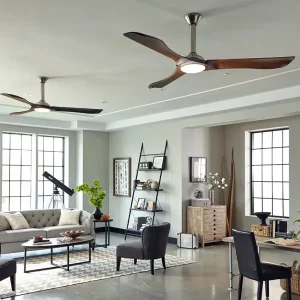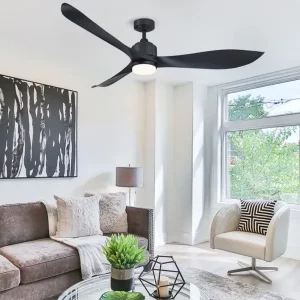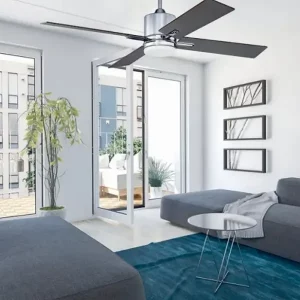Embrace the practicality of ceiling fans for effective climate control throughout the year. With their timeless functionality enhanced by modern advancements, ceiling fans offer an eco-friendly alternative to air conditioning. But how do you choose the best one for your home? Here’s everything you need to know to make an informed decision.
Understanding Ceiling Fan Terminology
When shopping for a ceiling fan, you’ll encounter specific terms. Here’s a quick glossary to help:
- Amperage: Measures the fan’s electricity consumption. Ensure it’s compatible with your home’s electrical system.
- Blades: These are crucial for air circulation. Confirm they are included and explore various styles for aesthetic flexibility.
- Blade Pitch: This indicates the angle of the blades, which affects air movement efficiency. It’s measured in degrees.
- Cubic Feet Per Minute (CFM): This is the air volume the fan moves at maximum speed. Higher CFM indicates better airflow.
- ENERGY STAR: Fans with this label are up to 40% more energy-efficient than standard models, potentially saving you significant money.
- Motor Size: Usually listed in millimeters (MM), a more significant number signifies a more powerful fan.
- Revolutions Per Minute (RPM): This indicates the fan’s operational speed. Multiple speed settings are standard.
- Vaulted Ceiling: Special considerations, such as a sloped ceiling adapter, are needed for higher, angled ceilings.
Ideal Locations for Ceiling Fans
Ceiling fans are best placed in areas where people gather, like living rooms or office lobbies, to enhance comfort without wasting energy. Consider the fan’s setting options for year-round utility:
- Summer Mode: Blades rotate counterclockwise to pull cool air upwards.
- Winter Mode: Clockwise rotation pushes warm air down to distribute heat evenly.
Types of Ceiling Fans From compact designs to elaborate setups, there’s a ceiling fan to fit every room:
- Standard Ceiling Fans: These are common in most homes, featuring 4-5 blades and energy-saving options.
- Low Profile Fans: Ideal for rooms with low ceilings, these fans mount flush to the roof, minimizing space.
- Fans with Light Kits: Combine illumination with airflow, which is suitable for living rooms or bedrooms.
- Downrod Fans: Best for high ceilings, downrods position the fan optimally for adequate air movement.
Specialty Fans For unique spaces or specific needs, consider these options:
- Dual-motor Fans: Offer directional airflow with two separate motors, ideal for large or commercial spaces.
- Commercial and Industrial Fans: Designed for large, open spaces with high ceilings, focusing on powerful airflow.
- Agricultural Fans: Built for durability in environments like barns or greenhouses, these fans withstand moisture and dirt.
Choosing the Right Fan Size
Safety first: Ensure the fan is installed at least 7 feet above the floor. The fan size should be determined by the room’s square footage and the desired airflow, measured by blade span.
Fan Features and Controls Modern fans come with various control options to suit your lifestyle:
- Pull Chains: Simple and effective for adjusting settings.
- Wall Switches: Convenient for integrating with smart home systems.
- Remote Controls: Offer the ultimate convenience with adjustable speed and lighting settings.
- Smart Home Compatibility: Some fans can be controlled via smartphone apps, providing custom settings based on room occupancy or time of day.
Energy Efficiency and Motor Types Choosing between AC and DC motors affects both energy consumption and operational noise:
- AC Fans: Common and cost-effective, suitable for a variety of designs.
- DC Fans: Use less energy and operate more quietly, which is ideal for energy-conscious households.
Selecting the right ceiling fan involves understanding your space, preferences, and the specific features that enhance your home’s comfort and style. Whether a chic light fixture fan for your living room or a robust outdoor model for your patio, the right fan can significantly improve your living environment.



